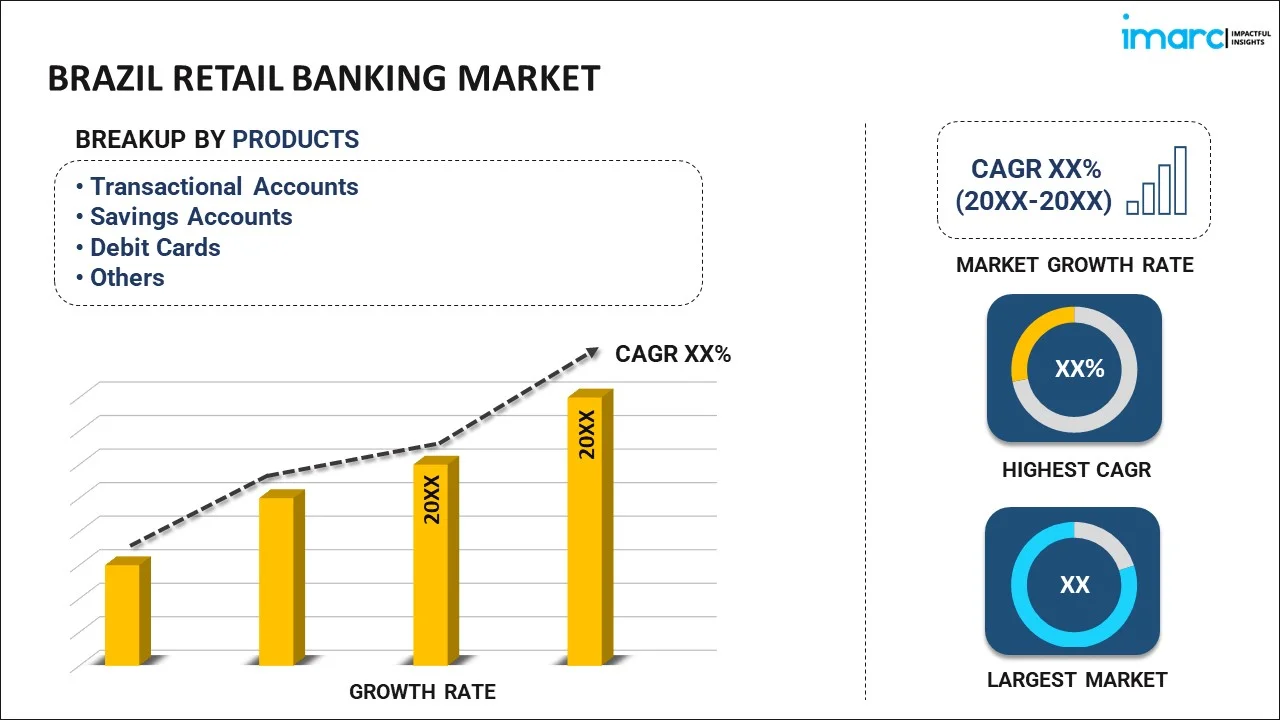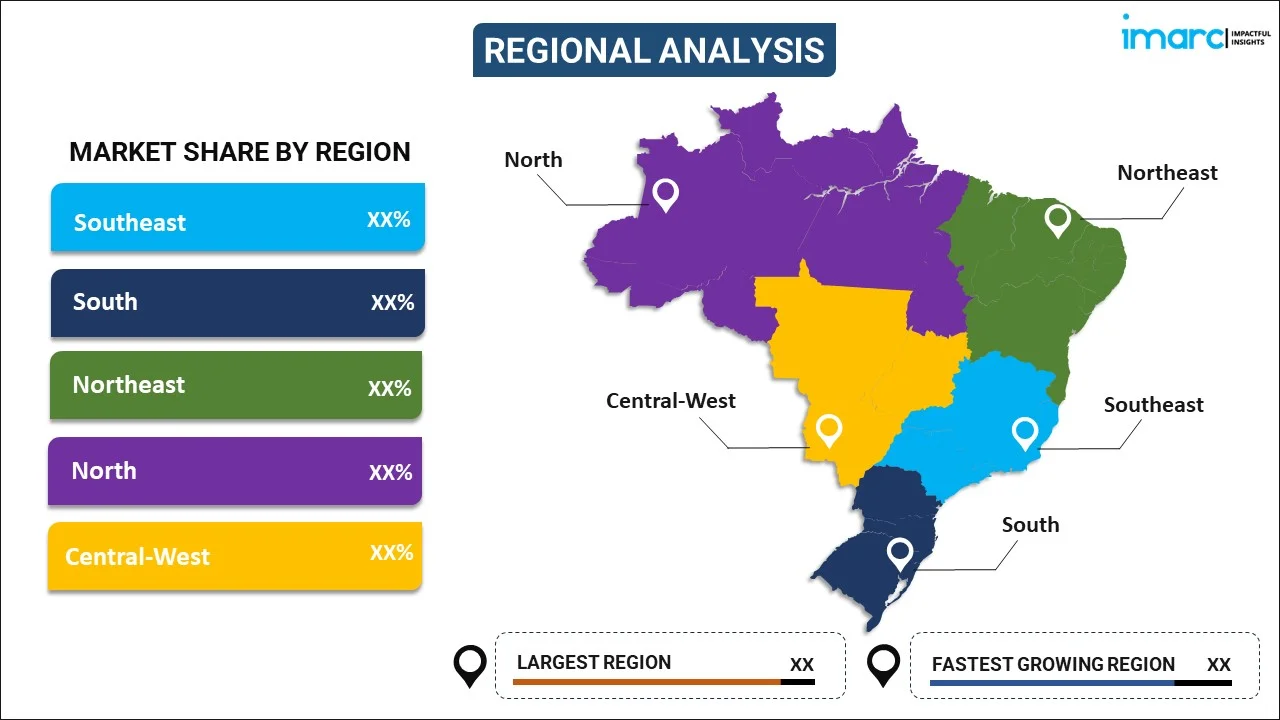
Brazil Retail Banking Market Report by Product (Transactional Accounts, Savings Accounts, Debit Cards, Credit Cards, Loans, and Others), Channel (Direct Sales, Distributor), and Region 2025-2033
Market Overview:
Brazil retail banking market size reached USD 65 Billion in 2024. Looking forward, IMARC Group expects the market to reach USD 151 Billion by 2033, exhibiting a growth rate (CAGR) of 9.8% during 2025-2033. Rapid digitization, the escalating demand for customer-centric services, a rising middle-class population, government initiatives for financial inclusion, availability of low-interest rates, partnerships of key players with fintech firms, advancements in cybersecurity, and regulatory reforms are propelling the market growth.
|
Report Attribute
|
Key Statistics
|
|---|---|
|
Base Year
|
2024
|
|
Forecast Years
|
2025-2033
|
|
Historical Years
|
2019-2024
|
|
Market Size in 2024
|
USD 65 Billion |
|
Market Forecast in 2033
|
USD 151 Billion |
| Market Growth Rate 2025-2033 | 9.8% |
Retail banking, also known as consumer banking, is a sector of the banking industry that serves individual consumers rather than businesses or institutions. It offers a wide range of financial services that include savings and checking accounts, personal loans, credit cards, mortgages, and various other investment products like fixed deposits. The core function of retail banking is to accept deposits from customers and extend loans, thereby facilitating the flow of money within an economy. In terms of operations, retail banks generally have an extensive network of physical branches and ATMs, although digital platforms are increasingly becoming more prevalent for customer convenience. Retail banking is easily accessible to the general public, providing a secure means for managing personal finances. It also serves as a cornerstone for economic development by encouraging savings and offering credit opportunities. The widespread presence of branches and automated teller machines (ATMs) ensures that banking services are available even in remote locations. Currently, various types of retail banking services exist to cater to specific needs: standard checking accounts for daily transactions, savings accounts for longer-term deposits, and specialized accounts, such as individual retirement accounts (IRAs) for retirement savings. Furthermore, modern retail banks often offer value-added services such as financial planning, insurance, and wealth management to provide a comprehensive financial solution for customers.
Brazil Retail Banking Market Trends:
The Brazil retail banking market is influenced by several key drivers, such as the significant expansion in the banking sector, along with the increasing penetration of digital platforms, which has significantly expanded the customer base, offering convenient banking solutions through mobile apps and online services. Moreover, the strong focus on customer-centric services, enabled by big data analytics, has led to personalized banking experiences, thereby increasing customer loyalty and satisfaction, which is fueling the market growth. This is further supported by the growing middle-class population, which has elevated the demand for various financial products, such as loans, credit cards, and investment options. Additionally, the government's push toward financial inclusion has led to increased branch expansion in remote areas, which is contributing to the market growth. Besides this, low interest rates have incentivized borrowing, promoting both consumer spending and business investment, which is providing impetus to the market growth. Furthermore, partnerships between traditional banks and fintech companies have led to product innovations, making banking services more efficient and less costly, which is boosting the market growth. In line with this, advancements in cybersecurity, the growth of the real estate sector, and increased public and private sector employment are propelling the market growth across the country.
Brazil Retail Banking Market Segmentation:
IMARC Group provides an analysis of the key trends in each segment of the market, along with forecasts at the country level for 2025-2033. Our report has categorized the market based on product and channel.
Product Insights:

- Transactional Accounts
- Savings Accounts
- Debit Cards
- Credit Cards
- Loans
- Others
The report has provided a detailed breakup and analysis of the market based on the product. This includes transactional accounts, savings accounts, debit cards, credit cards, loans, and others.
Channel Insights:
- Direct Sales
- Distributor
A detailed breakup and analysis of the market based on the channel have also been provided in the report. This includes direct sales and distributor.
Regional Insights:

- Southeast
- South
- Northeast
- North
- Central-West
The report has also provided a comprehensive analysis of all the major regional markets, which include Southeast, South, Northeast, North, and Central-West.
Competitive Landscape:
The market research report has also provided a comprehensive analysis of the competitive landscape in the market. Competitive analysis such as market structure, key player positioning, top winning strategies, competitive dashboard, and company evaluation quadrant has been covered in the report. Also, detailed profiles of all major companies have been provided.
Brazil Retail Banking Market Report Coverage:
| Report Features | Details |
|---|---|
| Base Year of the Analysis | 2024 |
| Historical Period | 2019-2024 |
| Forecast Period | 2025-2033 |
| Units | Billion USD |
| Scope of the Report | Exploration of Historical and Forecast Trends, Industry Catalysts and Challenges, Segment-Wise Historical and Predictive Market Assessment:
|
| Products Covered | Transactional Accounts, Savings Accounts, Debit Cards, Credit Cards, Loans, Others |
| Channels Covered | Direct Sales, Distributor |
| Regions Covered | Southeast, South, Northeast, North, Central-West |
| Customization Scope | 10% Free Customization |
| Post-Sale Analyst Support | 10-12 Weeks |
| Delivery Format | PDF and Excel through Email (We can also provide the editable version of the report in PPT/Word format on special request) |
Key Questions Answered in This Report:
- How has the Brazil retail banking market performed so far and how will it perform in the coming years?
- What has been the impact of COVID-19 on the Brazil retail banking market?
- What is the breakup of the Brazil retail banking market on the basis of product?
- What is the breakup of the Brazil retail banking market on the basis of channel?
- What are the various stages in the value chain of the Brazil retail banking market?
- What are the key driving factors and challenges in the Brazil retail banking?
- What is the structure of the Brazil retail banking market and who are the key players?
- What is the degree of competition in the Brazil retail banking market?
Key Benefits for Stakeholders:
- IMARC’s industry report offers a comprehensive quantitative analysis of various market segments, historical and current market trends, market forecasts, and dynamics of the Brazil retail banking market from 2019-2033.
- The research report provides the latest information on the market drivers, challenges, and opportunities in the Brazil retail banking market.
- Porter's five forces analysis assist stakeholders in assessing the impact of new entrants, competitive rivalry, supplier power, buyer power, and the threat of substitution. It helps stakeholders to analyze the level of competition within the Brazil retail banking industry and its attractiveness.
- Competitive landscape allows stakeholders to understand their competitive environment and provides an insight into the current positions of key players in the market.
Need more help?
- Speak to our experienced analysts for insights on the current market scenarios.
- Include additional segments and countries to customize the report as per your requirement.
- Gain an unparalleled competitive advantage in your domain by understanding how to utilize the report and positively impacting your operations and revenue.
- For further assistance, please connect with our analysts.
 Inquire Before Buying
Inquire Before Buying
 Speak to an Analyst
Speak to an Analyst
 Request Brochure
Request Brochure
 Request Customization
Request Customization




.webp)




.webp)












